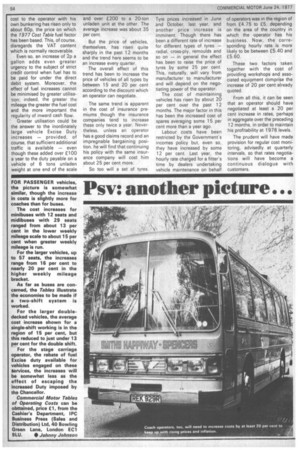Update your costing
Page 54

Page 55

Page 56

If you've noticed an error in this article please click here to report it so we can fix it.
CM's Tables spell out the message
FOR THE SECOND consecutive year, the cost of operating commercial vehicles has risen by an average of 20 per cent and for the second consecutive year, the Chancellor of the Exchequer must bear the major responsibility for the increase.
The extent to which costs have risen, as shown in CM Tables of Operating Costs to be published on July 1, will come
as no surprise to operators. But the continual onslaught by the Government on the industry's financial wellbeing — and the price of goods in the High Street shops — must be something of a puzzle.
Despite Mr Healey's television speech following the Budget in April and the machinations of the Prices Commission, increases in tran sport cost must inevitably be reflected in dearer food and other goods. The inference must be that while paying lip service to the control of inflation, the Government is adding fuel to it.
And -fuelis just about right, for this is one of the factors directly influencing rising transport costs weighted once again by the Chancellor in his April Budget; operators will not need reminding that the other increase he imposed was on vehicle Excise Duty.
Taking the fuel price increase first, some consolatio'n might be found in the fact that not all the 51/2p extra imposed is being passed on by the oil companies to the operator in any case the increase on petrol will be removed on August 15 because the Government's Liberal partners refused to support them on this issue.
As far as dery is concerned, it was obvious from the replies received to questionnaires sent out at the beginning of the year that operators taking bulk deliveries were paying little more for this fuel than in 1976.
The average cost of diesel fuel, last year, was 56p a gallon and by the beginning of 1977 This had risen to about 58p for frequent bulk supplies.
Even after the Budget, the cost to the operator with his own bunkering has risen only to about 60p, the price on which the 1977 Cast Table fuel factor has been based. This, of course, disregards the VAT content which is normally recoverable.
Even so, an increase of 2p a gallon adds even greater urgency to the subject of strict credit control when fuel has to be paid for under the direct debit system. Moreover, the effect of fuel increases cannot be minimised by greater utilisation; indeed, the greater the mileage the greater the fuel cost and the more important the regularity of inward cash flow.
Greater utilisation could be the answer to the inordinately large vehicle Excise Duty increases — provided, of course, that sufficient additional traffic is available — even though these added over £100 a year to the duty payable on a vehicle of 6 tons unladen weight at one end of the scale and over £200 to a 20-ton unladen unit at the other. The average increase was about 35 per cent.
But the price of vehicles, themselves, has risen quite sharply in the past 12 months and the trend here seems to be an increase every quarter.
The overall effect of this trend has been to increase the price of vehicles of all types by between 15 and 20 per cent according to the discount which an operator can negotiate.
The same trend is apparent in the cost of insurance premiums though the insurance companies tend to increase these only twice a year. Nevertheless, unless an operator has a good claims record and an impregnable bargaining position, he will find that continuing his policy with the same insurance company will cost him about 25 per cent more.
So too will a set of tyres. Tyre prices increased in June and October, last year, and another price increase is imminent. Though there has been a different rate of increase for different types of tyres — radial, cross-ply, remoulds and so on — in general the effect has been to raise the price of tyres by some 25 per cent. This, naturally, will vary from manufacturer to manufacturer and will depend on the negotiating power of the operator.
The cost of maintaining vehicles has risen by about 20 per cent over the past 12 months. The major factor in this has been the increased cost of spares averaging some 15 per cent more than a year ago.
Labour costs have been restricted by the Government's incomes policy but, even so,_ they have increased by some 12 per cent. Last year, the hourly rate charged for a fitter's time by dealers undertaking vehicle maintenance on behalf of operators was in the region of from £4.75 to £5, depending on the area of the country in which the operator has his business. Now, the corresponding hourly rate is more likely to be between £5.40 and £5,60.
These two factors taken together with the cost of providing workshops and associated equipment comprise the increase of 20 per cent already quoted.
From all this, it can be seen that an operator should have negotiated at least a 20 per cent increase in rates, perhaps in aggregate over the preceding 12 months, in order to maintain his profitability at 1976 levels.
The prudent will have made provision for regular cost monitoring, advisedly at quarterly intervals, so that rates negotiations will have become a continuous dialogue with customers.




































































































